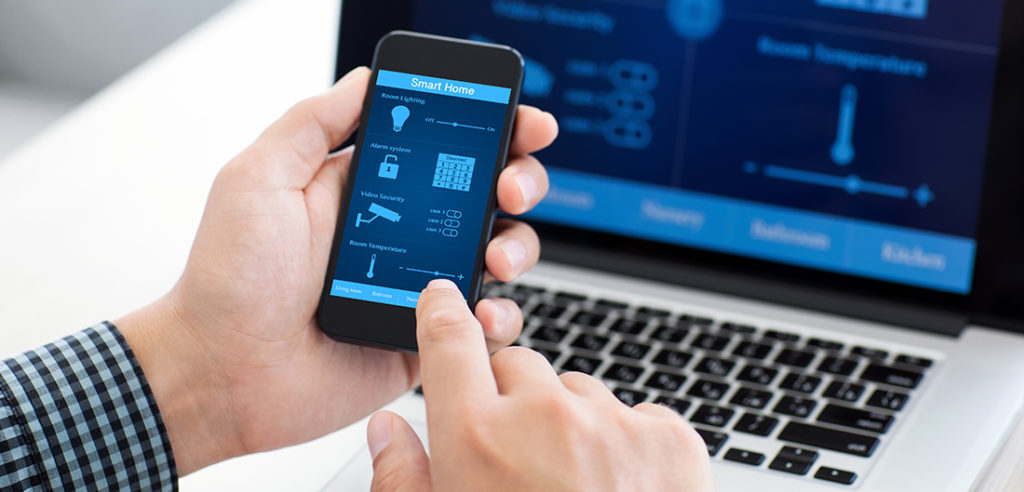 If the idea of a smart home interests you, you’re in good company. Thousands of homeowners across the nation are adopting smart home technology to improve their quality of life and their home security. But despite the benefits of smart home technology, installing these products can be confusing.
If the idea of a smart home interests you, you’re in good company. Thousands of homeowners across the nation are adopting smart home technology to improve their quality of life and their home security. But despite the benefits of smart home technology, installing these products can be confusing.
The most basic smart home technology follows similar steps, so if you’re looking for how to install video cameras, digital thermostats or door locks, read on to discover how.
Video Cameras
Video cameras are a core component of a smart home. Updated video cameras make at-home monitoring easier than ever before. Now, many video cameras can detect motion and can automatically send a photo and alert to your smart phone. You can decide whether to contact the authorities or ignore it completely. Some video cameras are capable of contacting the police with the press of a button.
Installing Video Cameras
It’s all about location: Depending on the camera, this may be indoors or out. If the camera is an outdoor camera, check its IP rating. If the camera is IP66 or higher, it can be fully exposed to the elements. If it is IP65 or lower, it should be placed under eaves.
Out of Sight: You should also ensure the camera is placed high enough that it isn’t immediately noticeable from the ground and can’t be pulled down or damaged. A height of 10 to 12 feet is usually enough.
Power On: Once you have mounted the camera, secure the power cable to the wall or drill a hole to feed the cable through. Keeping cables as inconspicuous as possible is important; after all, you don’t want to draw unwanted attention to the camera’s placement. Plug in the power cable and then use either your phone or computer to finalize the setup process for the camera.
Walk the property: Take a moment to walk outside and test the sensitivity of the camera. Look for motion alerts and familiarize yourself with the various settings. If it is possible to set up “zones,” highlight only the area in your yard you want to monitor so you aren’t alerted to activity on the roadway or in a neighbor’s yard.
Erie Insurance provides discounts for burglary alarms. If you set up a monitored security camera, check with your agent to see if you qualify for savings on your homeowners insurance.
Smart Thermostats
Smart thermostats can help cut down on the heating and cooling costs of your home by automatically adjusting the temperature when you aren’t around. Though it requires a bit of electrical work, installing a smart thermostat isn’t as difficult as you might believe.
Installing your Thermostat: Remove the front panel from your existing thermostat. Look for a wire labeled “common,” or look for the letters “C,” “W” or “R.” If you find these wires, then you can usually install a smart thermostat without a problem. If you can’t locate a “C” or “common” wire, speak to an electrician about your system; it may require rewiring for compatibility.
Note: High-voltage thermostats and systems are typically incompatible with smart thermostats. Turn off the circuit breaker to your thermostat and HVAC unit; when working with electricity, it is always better to be safe than sorry. Remove your existing thermostat and disconnect any wires attached to it.
Do a Double Check: Consult the owner’s manual of your new smart thermostat. Different thermostats have different installation processes, but they all boil down to the same basic dynamics: connect the proper wires and replace the faceplate. Once you have done this, turn the power back on to your unit and follow the steps to complete the installation and setup processes.
Getting to Know You: Your smart thermostat will take several days to learn your habits, but once it does, your home will automatically adjust for your presence. Some thermostats even account for the weather outside and offer the feature for you to adjust the settings remotely via a mobile app or online portal.
Smart Door Locks and Entry Control
If you’re worried about smart lock compatibility, you can breathe easy. Most smart locks are compatible with most doors. If any modifications are needed, they will be minor. Make sure to check the smart lock you’re interested in; some are designed to only work with deadbolts, and if your lock has a handle the smart lock may not work with it.
Installing a smart lock is very similar to installing a traditional door lock or deadbolt.
Easy Installation: Remove your existing door lock and consult the instructions on your new smart lock. Some may require that you attach a cable or two. Almost all smart locks require batteries, but most come with a key override you can use if the batteries die.
Keeping Safety in Check: Smart locks can automatically lock after a few seconds, which provides endless peace of mind if you’re a forgetful person. Nothing is worse than wondering if you locked your door. They also allow you to remotely control your door lock from your smart phone. If you need to let someone into your home while you’re away, all you have to do is press a button on the mobile app.
Peace of Mind: An especially important safety feature for parents is that smart locks keep a timeline of entry. You can check exactly what time your kids came home from school and when they leave to go somewhere.
Installations Made Easy
Most companies have professional installation teams that can set up your smart home for a small fee, but the majority of smart home components are easy to install. Also, inquire if your local cable company offers a home security solution as you could add it to your services and enjoy a bundled discount. Before you spend money out of pocket for installation, do some research and consider whether it would be easier to do it yourself. Even if you’ve never worked with tools before, smart home technology is designed for easy installation. Read the instructions closely and keep the customer service number of the smart home company handy.
If you’re thinking about upgrading your house with smart home technology – or have done so recently, make sure you talk to your ERIE agent. He or she could help you figure out if your smart home upgrades will save you money on your homeowners insurance.
Patrick Hearn is a writer for XFINITY Home based out of Atlanta, Georgia. When not searching for Atlanta’s best cup of coffee, he can be found on the tennis courts improving his forehand.


